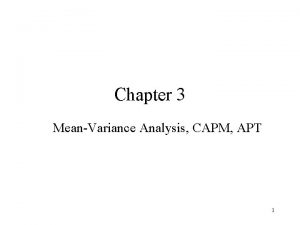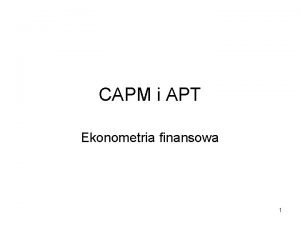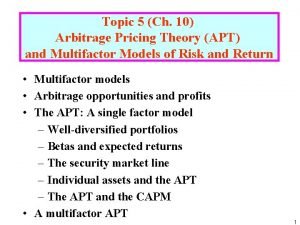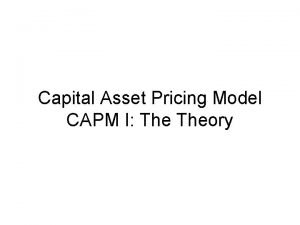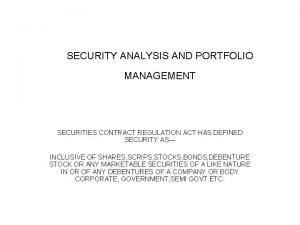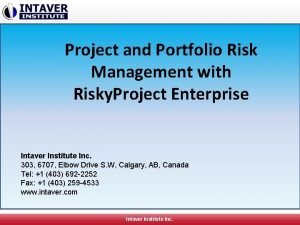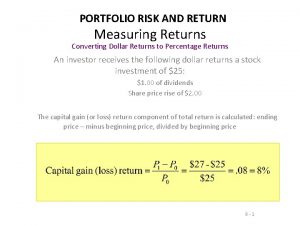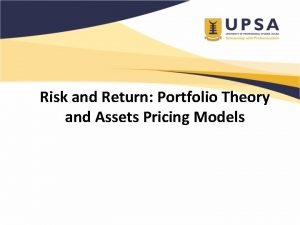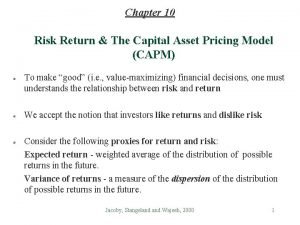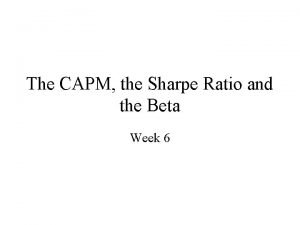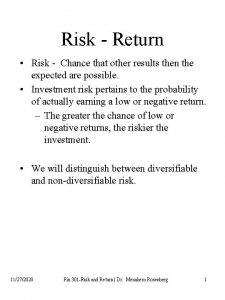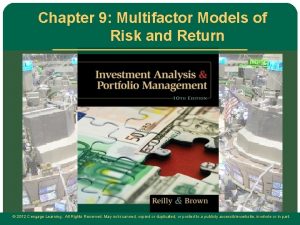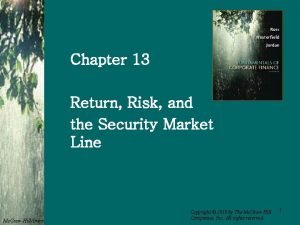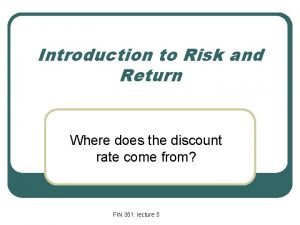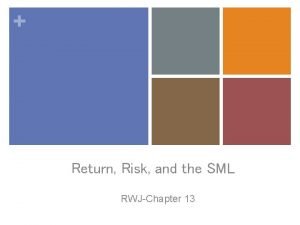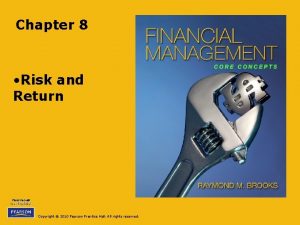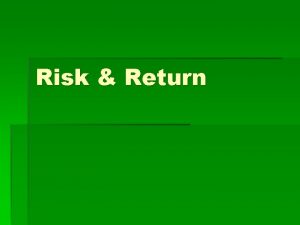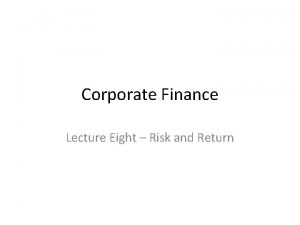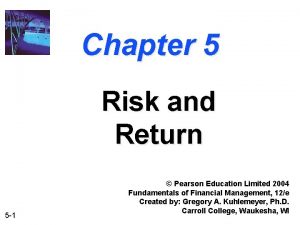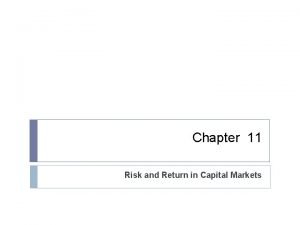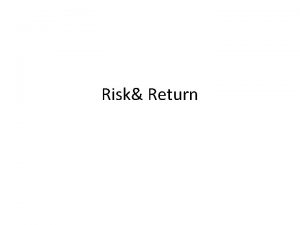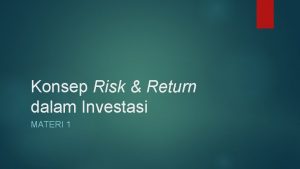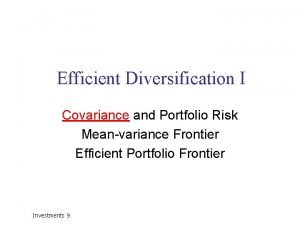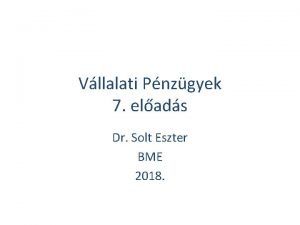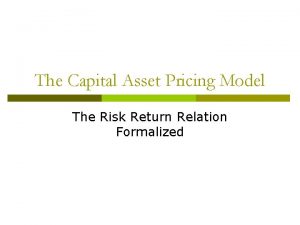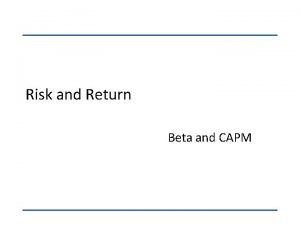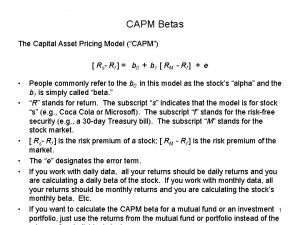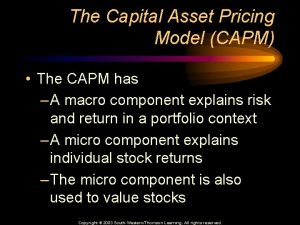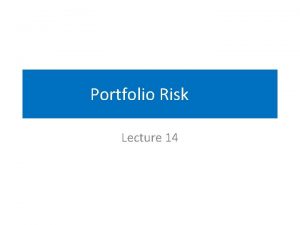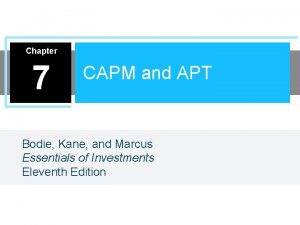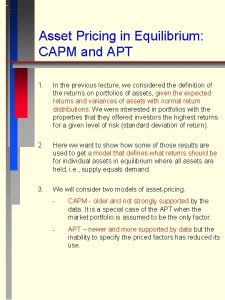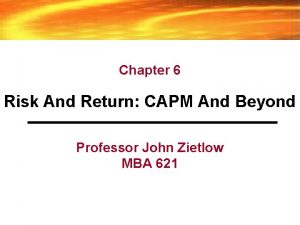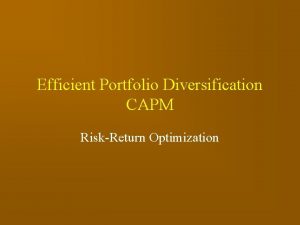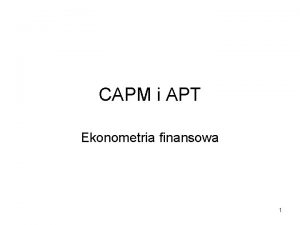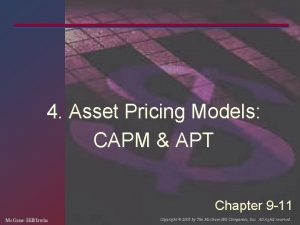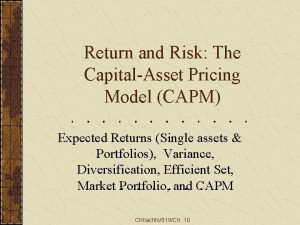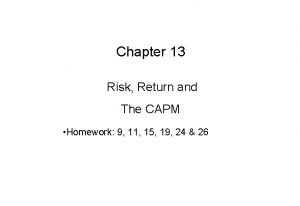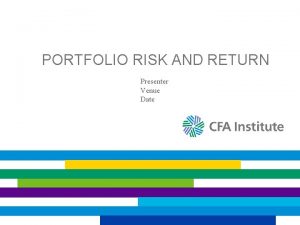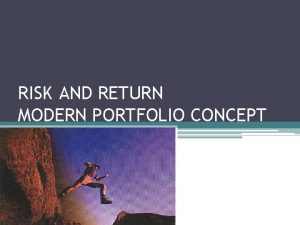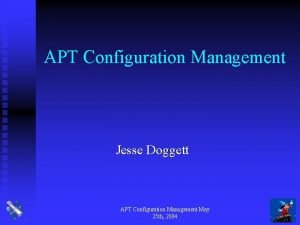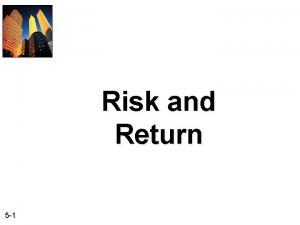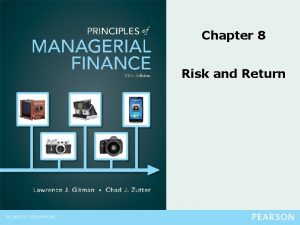CAPM APT Summary Risk and Return Portfolio Return




































- Slides: 36

CAPM & APT

Summary § Risk and Return. § Portfolio Return and Risk § Diversification § Investors should diversify, thus individual securities will be held in a portfolio. § The risk that cannot be diversified away, i. e. , the risk that remains when the stock is put into a portfolio, is called systematic risk (or non-diversifiable risk). § Examples of such events include a change in interest rates or GDP; or a financial crisis such as that which occurred in 2007 and 2008. § Optimum Risky Portfolio § Capital Allocation Line vs. Capital Market Line § Complete portfolio (combination of risk-free rate and optimum risky portfolio) provide more return per unit of risk are superior regardless of an individual’s risk tolerance (the principle of separation) § That is, portfolio choice can be separated into two independent tasks: § (1) determination of the optimal risky portfolio and § (2) the personal choice of the best mix of the risky portfolio and the risk free asset. CAPM & APT 2

Measuring Risk in a Well-diversified portfolio § If a well diversified portfolio has no unsystematic risk then any risk that remains must be systematic; § The variation in returns of a well-diversified portfolio must be due to changes in systematic factors. § Remember: § (1) Total Risk of an individual asset = Systematic risk + Unsystematic risk § (2) The state of economy impacts securities in a different way § (3) If we hold well-diversified portfolio, any individual asset’s risk depends on the sensitivity of the asset on the systematic risk ONLY. § How can we measure the risk of an individual stock in a well diversified portfolio? ? CAPM & APT 3

A Single-Index Stock Market § The scatter plot can also be used to illustrate systematic and unsystematic risk. § The risk is related to the systematic or macroeconomic factor, in this case the market index. § A stock’s total risk, as measured by its standard deviation, can be partitioned into systematic and unsystematic risk. CAPM & APT 4

Understand the Components of a Single-Index Model Excess Return of a Security Expected return on the security’s in excess of riskfree rate beyond any induced by movements in the broad market CAPM & APT Excess Return of Market The security’s sensitivity to market-wide economic shocks – measure of systematic risk Firm Specific Surprises 5

More about Beta - What does Beta represent? § Beta is the measure of the amount of systematic risk a stock has, or equivalently the amount of risk a stock will have when it is put into a well diversified portfolio. Ri-rf Rm-rf Variance of Market CAPM & APT 6

Example 1) § A stock has a correlation with the market of 0. 45. The standard deviation of the market is 21% and the standard deviation of the stock is 35%. What is stock’s beta? CAPM & APT 7

Answer 1) CAPM & APT 8

Beta for Selected Induvial Stocks CAPM & APT Company Consolidated Edison Hershey General Mills Industry Utilities Food Processing Beta 0. 08 0. 64 0. 73 e. Bay Internet Service 0. 79 Intel Apple Google Salesforce. com Tiffany & Co. American Airline Semiconductors Computer Hardware Internet Service Application Software Specialty Stores Major Airlines 0. 90 0. 96 1. 07 1. 30 2. 15 3. 85 9

Measuring Components of Risk § A stock’s total risk, as measured by its standard deviation, can be partitioned into systematic and unsystematic risk. Total Risk or Total Variance Systematic Variance Idiosyncratic Variance The ratio of explained variance to total variance. The proportion of total variance can be attributed to market fluctuations CAPM & APT 10

Total Risk vs. Beta • Consider the following information: Cisco Amgen Standard Deviation 20% 40% Beta 1. 43 0. 58 • Which stock has more systematic risk? • Which stock has more total risk? CAPM & APT 11

Single Index Model and Finding Beta in Python • Launch U 6 -CAPM • Step 1, 2, 3 CAPM & APT 12

Example 2) § You run a regression for a stock’s return on a market index and find the following output: § What is the beta? § If standard deviation of market is 20%, what is the standard deviation of the stock associated with market? § What is the standard deviation of idiosyncratic risk? CAPM & APT 13

Answer 2) CAPM & APT 14

Capital Asset Pricing Model (CAPM) § The CAPM defines the equilibrium relationship between risk premium, market risk premium, and beta. § Developed by William Shape, extension of Markowitz with some important differences! Market Assumptions Investor Assumptions All investors are price takers Investors plan for the same (single-period) horizon All information relevant to security analysis is free and publicly available. Investors are efficient users of analytical methods investors have homogeneous expectations. All securities are publicly owned and traded. Investors are rational, mean-variance optimizers. No taxes on investment returns. No transaction costs. Lending and borrowing at the same risk-free rate are unlimited. CAPM & APT 15

CAPM § In his model, Sharpe include risk-free rate and introduce the concept of a market portfolio that is a bundle of all possible investments in the world (both bonds and stocks and more). § Such a market portfolio is superior to any other portfolio (“superior optimum” or “theoretical” portfolio) and contains no idiosyncratic risk => only risk is systematic risk!!! CAPM & APT 16

CAPM & APT 17

Security Market Line CAPM & APT 18

Example 3) – Understanding SML and alpha § Stock with Beta=1. 2 § E(Rm)=14% § Rf=6% CAPM & APT 19

Implications (I) – Reward to Risk Ratio CAPM & APT 20

Implications (II) – Portfolio Beta CAPM & APT 21

Example 4) • Suppose we had following investments: Security Amount Invested Beta Stock A 1, 000 0. 80 Stock B 2, 000 0. 95 Stock C 3, 000 1. 10 Stock D 4, 000 1. 40 • What is the beta of this portfolio? • Does this portfolio have more or less systematic risk than the market portfolio? Return, Risk, and SML 22

Answer 4) Return, Risk, and SML 23

Example 5) § A stock has a beta of 1. 13, the expected return on the market is 10. 7%, and the risk-free rate is 4. 6%. What must the expected return on this stock be? CAPM & APT 24

Answer 5) CAPM & APT 25

Example 6) Stock Y has a beta of 1. 25 and an expected return of 12. 6%. Stock Z has a beta of 0. 8 and an expected return of 9. 9%. a) If the market is now in equilibrium, what would the risk-free rate have to be? b) If the risk-free rate is 4. 1% and market risk premium is 7%, are these stocks correctly priced? Why? CAPM & APT 26

Answer 6) § In equilibrium: CAPM & APT 27

Example 7) • You are examining two stocks – Bassett Inc and Hound Corporation. The risk-free rate is 3% and the return of market portfolio is 8%. The following table provides some information. Next year Beta Current Price Dividends (D 1) Price (P 1) Bassett 1. 1 $25 $1. 00 $26. 13 Hound 0. 8 $30 $1. 20 $34. 00 a) According to the CAPM, what is the expected return of the stock of Bassett Inc and Hound Corporation? b) What is the actual percent return of the stock of Bassett Inc and Hound Corporation? c) Draw the Security Market Line (SML), label axes, identify risk free asset and market portfolio. Identify where Bassett and Hound actually lie on this graph. d) If you buy 200 shares of Bassett and 200 shares of Hound and $5, 000 in Treasury bills, what would the portfolio beta be? CAPM & APT 28

CAPM in Real World CAPM is false based on validity of its assumptions • Useful predictor of expected returns • Untestable as a theory • Principles still valid • Investors should diversify • Systematic risk is the risk that matters • Well-diversified risky portfolio can be suitable for wide range of investors CAPM & APT 29

Multifactor Models and the CAPM Multifactor models • Models of security returns that respond to several systematic factors • Two-index portfolio in realized returns • Two-factor SML CAPM & APT 30

Example 8) § There are two independent economic factors, M 1 and M 2. The risk-free rate is 5%, and all stocks have independent firmspecific components with a standard deviation of 25%. Portfolios A and B are well diversified. Given the data below, which equation provides the correct pricing model? CAPM & APT Portfolio Beta on M 1 Beta on M 2 E[rp] A 1. 5 1. 75 35% B 1 0. 65 20% 31

Solution 8) § 35 = 5 + 1. 5 x E(Rm 1) + 1. 75 x E(Rm 2) … (1) § 20 = 5 + 1. 0 x E(Rm 1) + 0. 65 x E(Rm 2) … (2) § Solve them for E(Rm 1) and E(Rm 2). § E(Rm 1)=8. 71%, E(Rm 2)=9. 68% CAPM & APT 32

Fama-French Three (Five) factor Model § The Fama-French (FF) three factor model has become a standard in equity analysis. § § What is FF Model? § The FF model was developed because the researchers found that stocks of smaller firms, and of firms with a high book-to-market ratio, had higher stock returns than predicted by single factor models. § Recently, FF included and profitability and asset growth! § Critique of FF Models: § The FF model is based on empirical regularities that are apparently longstanding in the data. § Nevertheless it is a model without a sound theoretical underpinning. § This raises questions about whether the priced factors will remain significant in the future. CAPM & APT 33

Basic Intuition of the Factor Models § Let’s compare small vs large stocks and growth vs. value stocks. § Launch U 6 -CAPM - STEP 4 § If small firms, on average, outperform large firms => do you think a manager who is investing small (value) firms is better manager than other manager who is investing large (growth) firms? Or simply taking some risk? ? § Factor models attempt to compare skills of managers or portfolios by controlling for certain documented patterns (small stock premium or value premium or profitability premium etc. ) CAPM & APT 34

CAPM, 3 - and 5 -Factor Model in Python • Launch U 6 -CAPM • Step 5 CAPM & APT 35

Thanks! 36
 Assumptions of apt
Assumptions of apt Capm apt
Capm apt Model apt
Model apt Arbitrage pricing theory
Arbitrage pricing theory Capm expected return
Capm expected return Capm derivation
Capm derivation Market risk assessment
Market risk assessment Mission statement as a student
Mission statement as a student Risk in security analysis and portfolio management
Risk in security analysis and portfolio management Project and portfolio risk management software
Project and portfolio risk management software Variance of 3 asset portfolio formula
Variance of 3 asset portfolio formula Portfolio variance
Portfolio variance Capital market line
Capital market line Jensen alpha ratio
Jensen alpha ratio Sharpe ratio vs capm
Sharpe ratio vs capm Risk and return
Risk and return Risk and return
Risk and return Risk and return
Risk and return Multifactor model of risk and return
Multifactor model of risk and return Financial management chapter 8 risk and return
Financial management chapter 8 risk and return Chapter 13 return risk and the security market line
Chapter 13 return risk and the security market line Introduction to risk and return
Introduction to risk and return Risk and return
Risk and return Chapter 8 risk and rates of return problem solutions
Chapter 8 risk and rates of return problem solutions Konsep risk and return
Konsep risk and return Difference between risk and return
Difference between risk and return Chapter 5 risk and return
Chapter 5 risk and return Difference between risk and return
Difference between risk and return Assume risk and return are positively related
Assume risk and return are positively related Konsep risk and return
Konsep risk and return Covariance in portfolio risk
Covariance in portfolio risk Residual risk and secondary risk pmp
Residual risk and secondary risk pmp Business vs financial risk
Business vs financial risk Attributable risk formula
Attributable risk formula Relative risk and attributable risk
Relative risk and attributable risk Camp modell
Camp modell Portfolio diversification eliminates
Portfolio diversification eliminates

